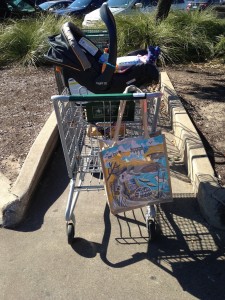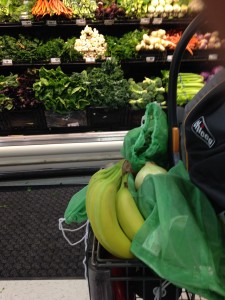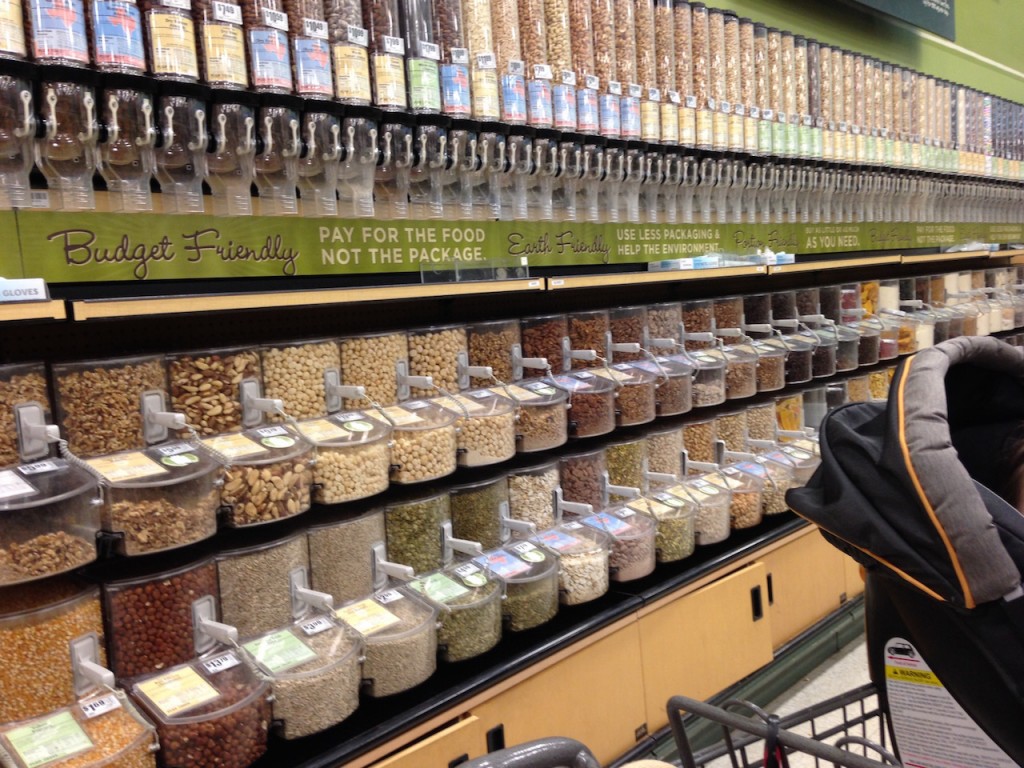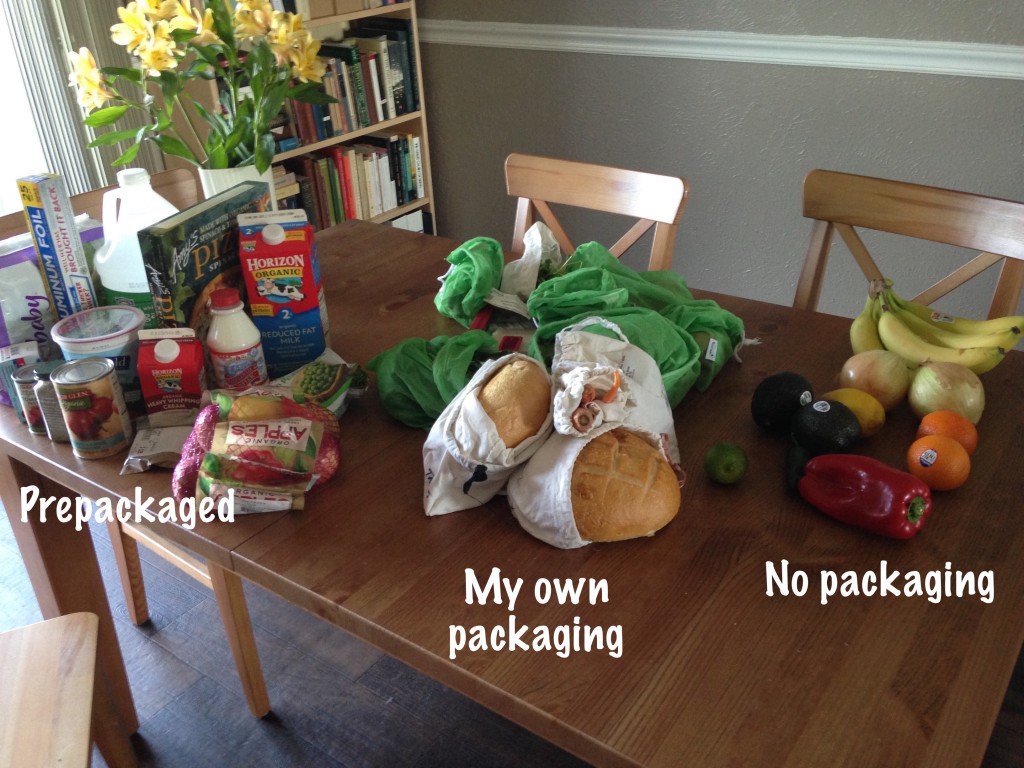I’ve now made three shopping trips to my usual supermarket trying to follow zero waste habits as much as possible.
First I get my gear: Edith’s car seat, my shopping kit, and my canvas bags. I think that as soon as you start bringing your own shopping bags – per the norm many places now – it’s relatively easy to remember other reusable bags as well. Mentally it’s all part of the same kit.
We trundle into the store and hit produce first. This is becoming old hat, since I’ve been using mesh bags for fruit and veg a while now, and any single items I just place directly in my trolley (like one onion). In a few cases, my ‘usual’ variety is packaged in plastic but I can opt for a loose version: lettuce, bell peppers, snow peas. Having the decision predetermined is kind of a relief. Baby corn is only available in a stir-fry pack, so I just skip it. Apples are a conundrum for me: the loose organic apples are gigantic, and if I buy enough for a week, I sometimes spend $10 on apples because they are priced by the pound. Whereas the smaller apples are available only in snazzy zip-top bags. I’m postponing this issue for now and go for the plasticky version.
After the produce section I cruise to the deli counter. For a long time, each week I have requested ‘half a pound of artisan white cheddar, sliced on a 2’. It normally comes with wax paper between each slice, in a ziplock bag. But instead I hold up my Pyrex container and ask to have the cheese put in it, without the wax paper. The first time, the woman behind the counter asked a manager’s permission, but since then my request has been unquestioned. The cheese fits nicely, and frankly it’s nice not to bother with the ziplock bags, which always tear.
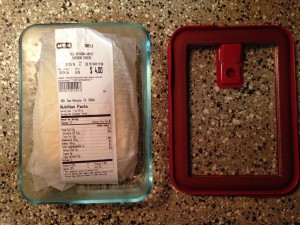
I usually buy bread from the bakery counter, pre-sliced in a plastic bag. They have the same loaves, unsliced, loose. Apparently they won’t slice the loose loaves and let me put them in my own bag, so it’s either pre-sliced in plastic, or un-sliced in my own bag.
In the bulk aisle, I get some trail mix, granola, and happily find that pinto beans have been added with a label proclaiming ‘New’. We eat tons of pinto beans, so that’s good for me. I label and weigh my items. It irks me that I can’t tare the scale (at least I haven’t figured out how), so I’m essentially paying to use my own bags because I’m paying per pound for their weight as well as the food’s. Edith stares placidly at the opposite side of the aisle, at the packages of gluten free foods and natural bar soaps. The location and contents of the bulk aisle make it clear what type of shopper is expected: they contain multiple varieties of granola and almonds opposite the natural body products. I do wish they had more typical staples like pasta, plain flour and the like. But it’s still an impressive selection for an ordinary supermarket, and includes herbs and spices, peanut butter, and honey. (I never saw anything like this in the UK.)
It’s the meat counter next. I have mixed feelings about this. I can get almost any meat from the counter, but none of the organic or free-range types I would normally buy. So which is the better choice? In the end, I proffer another Pyrex container for a pound of ground beef, and being out of containers I get chicken and stewing bones in a cling-filmed package. But as with the cheese, my Pyrex container is easier to use than the store’s packaging: prying raw meat from the corners of the sealed plastic squares is something I always dread. It’s a relief just to tip it out from glass.
I will say, by this time, it feels as if I’ve been shopping forever. If I weren’t using my own containers I could grab all of these items prepackaged and throw them into my basket almost without stopping.
The next section is chilled foods, where I buy milk, eggs, yogurt and block cheese. I don’t feel there’s much zero waste alternative for these without finding an alternative source. But I’m not stressing about that now. One thing at a time!
After this, the ‘inner aisles’ of the store await: boxes, bags, cans, drinks, etc. I didn’t buy a lot of inner-aisle foods before, but when I’m shopping with zero waste in mind, I buy even less. Have you heard the advice to ‘shop the perimeter of the store’? The assumption is that most supermarkets place unpackaged or real foods around the edges – the sections where I’ve just been – and the inner aisles tend to contain more packaged and processed foods. If you were devotedly zero waste, you’d avoid the inner aisles altogether and be forced to eat a pretty healthy diet.
At the checkout, I stand by to explain anything to the cashier. So far none have complained or need much guidance. I do try to make things easy for them, by placing containers with the sticky labels clearly visible and facing the same way.
At home, I try to get everything out of the reusable bags and into the fridge or containers in the pantry. That way I can wash my bags and have them ready for the next trip.
Here’s the result from this week’s shop. I was curious to see what percentage of my shopping was really zero waste. Probably 50-60%. You’ll see that on this trip I bought tin foil and disposable diapers…the antithesis of zero waste! Just being honest.
You may be wondering how zero waste is affecting our food budget. This month, I’m not closely tracking it item-by-item, but I am monitoring whether we are staying within the budget overall. At this point we are.
Next up: Whole Foods.
